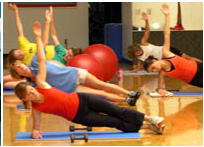 Feeling like your workout is in a rut? If you have been just one size away from you “skinny jeans” for so long you’ve given up hope or know the exact sequence of your favorite group exercise class so well you could teach it, you need a kick-start! Consider these tips adapted from Women’s Health Magazine and get ready for jeans and tank top season!
Feeling like your workout is in a rut? If you have been just one size away from you “skinny jeans” for so long you’ve given up hope or know the exact sequence of your favorite group exercise class so well you could teach it, you need a kick-start! Consider these tips adapted from Women’s Health Magazine and get ready for jeans and tank top season! Figure out how many calories you should be consuming: If you have lost weight since you first estimated your daily caloric needs your basal metabolic rate is probably lower, which means your body needs less calories to sustain the smaller you. Figure out your BMR:
Divide your current weight by 2.2 pounds.
Multiplying this number by 0.9, and then by 24. (Or calculate it at bmicalculator.net/bmrcalculator.)
Multiply your BMR by 1.2
This is the average number of calories your body burns each normal activity day. (Add another 300 to 500 on days you do an hour of moderate to intense exercise.)
Subtract 500 to find out how many calories you need to eat to lose a pound a week, or 300 to lose 2 pounds a month!
Make sure you are eating enough, never decrease your calories to less than 1200/day. If your body is not getting enough nutrients, your brain will try to conserve energy by signaling your metabolism to slow down. This can decrease activity of endocrine organs like your thyroid, making you feel sluggish and making weight loss extremely difficult.
Switch your workout around. Anytime your body has to do something different than what it is used to it has to work harder. If you have been going to the same fitness class or running the same 3 mile route for 6 months, switch things up! Run the route in reverse forcing you to do the big hills at the beginning or add on an extra ½ mile. Try using weight machines rather than attending your regular weight class. Even simply swapping lunges for leg extensions works. Whatever you choose, make sure you are switching your routine up at least every 6 months.
Give yourself a rest. Your muscles need time to replenish and grow stronger. Try resting for one day between 2 hard workout days. This not only allows your muscles to get stronger and therefore burn through more calories but will also allow you to work harder when you return to your routine. Just try to limit your rest days to 2 in a row.
Speed up your metabolism. We already talked about how to use exercise to make your body work harder. You can also give your metabolism a boost by eating good fats (mono’s and poly’s) and healthy lean protein. Spicy food and distributing your calories over several small meals throughout the day may also do the trick.
Now get out there and storm through your platea!




